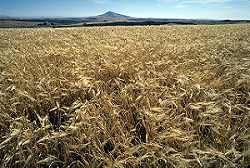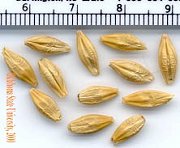|
|
 |
| Welcome | Getting Started | Resources | Site Map |
Week 2
High-Energy Feedstuffs |
Instructions for listening to audio clips
- Download the QuickTime Player to listen to the audio files.
- Read the QuickTime Instructions for installation help.
- Download the RealPlayer to listen to the audio files
- Instructions are on the RealPlayer download page
Barley
Time: 2.59
Follow along with the audio...
- In U.S., third most important cereal grain
- Estimated production – 249 million bushels
- Growing conditions
- Cool, dry climates
- Short growing seasons
- Relatively important feedstuff in PNW
- Figure 4.11 – Field of barley
- Use in brewing industry
- By-products
- Hulls
- Brewer’s grain
- Primary use as feedstuff
- Hull feed barley
- Figure 4.12 - Barley grain on the head
- Figure 4.13 – Barley grain
- Estimated average yield – 58.2 bu/acre
- Coarse grain
- Cereal grains with relatively low energy values
- Nutritional value
- Table 4.4 – Average nutrient composition of barley
- Energy source
- Significantly lower than corn and milo
- Low starch, high fiber, beta-glucans
- Beta-glucans
- Water soluble CHO
- Indigestible by mammalian enzymes
- Digestible by microbial enzymes
- Protein source
- Higher content than corn
- Higher lysine, tryptophan, methionine, and cystine than corn
- Content similar to wheat
- Feeding livestock
- Processed to improve nutritional value
- Palatable for ruminants and horses; lower for monogastrics
- Cattle, horses, and swine
- Fed in combination with other grains for production and health reasons
- Poultry
- Amount fed limited



Nutrient |
Average Composition,
% |
|---|---|
Crude protein |
13.3 |
Ether extract |
2.0 |
Crude fiber |
6.3 |
Ash |
2.7 |
NFE |
75.7 |
Starch |
64.6 |
| |
| Welcome | Getting Started | Resources | SiteMap |